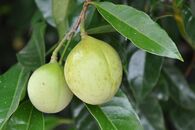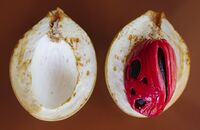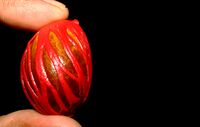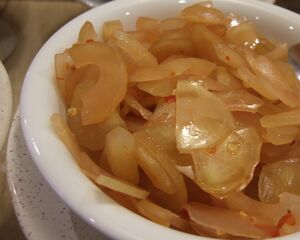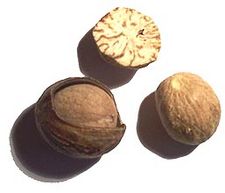جوزة الطيب
| جوزة الطيب Nutmeg | |
|---|---|
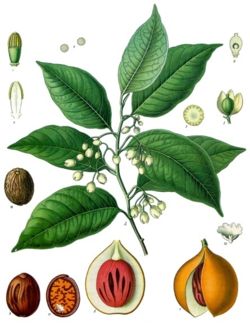
| |
| Myristica fragrans | |
| التصنيف العلمي | |
| مملكة: | |
| Division: | |
| Class: | |
| Order: | |
| Family: | |
| Genus: | Myristica Gronov.
|
| Species | |
|
About 100 species, including: | |
جوزة الطيب (Nutmeg) وتسمى في العراق باسم جوزة بوه وهي بذور تفيد في تنشيط الدورة الدموية. وتقلل إلتهاب المفاصل ولاسيما المصاحبة بالنقرس . ويتجنب زيتها مرضي القلب والحوامل والأطفال أقل من 5 سنوات. تفيد في الناحية الجنسية . وتناولها بكميات كبيرة تسبب الهلوسة وزغللة العين . وبها مادة مريستيسين لها قدرة علي عبور المشية للحامل مما يزيد ضربات فلب الجنين .عرفت شجرة جوزة الطيب منذ قديم الزمان قبل التاريخ الميلادي ، اذ كانت تستخدم ثمارها كنوع من البهار التي تعطي للأكل رائحة ونكهة لذيذة ، واستخدمها قدماء المصريين دواء لآلام المعدة وطارد للريح.
شجرة ارتفاعها حوالي عشرة أمتار ، دائمة الخضرة ، ولها ثمار شبيهة بالكمثرى ، وعند نضجها يتحول ثمارها إلى غلاف صلب ، وهذه الثمرة هي ما يعرف بحوزة الطيب ، ويتم زراعنها في المناطق الاستوائية وفي الهند واندونسيا وسيلان .
وهي نبات يتبع الفصيلة البسباسية، وقد عرفه العرب واستعملوا بذوره، وتتميز أشجاره بالأوراق المتبادلة كاملة الحافة، بيضاء الأسطح السفلي، أما الأزهار فهي بيضاء صغيرة في مجموعات خيمية، والثمار لحمية تفتح بمصراعين أو أربعة. وتعرف بجوزة الطيب.
تُلقّب ثمرة جوزة الطيب بلقب أميرة الأشجار الاستوائية، وإن مبعث هذه التسمية أن هذه الثمرة لها جنسان ، مذكر ومؤنث، وإن نبتة واحدة من الجنس المذكر كافية لإخصاب عدد كبير من الجنس المؤنث.
وتنمو شجرة الطيب في المناطق الاستوائية، ويبلغ ارتفاعها حوالي عشرة أمتار، وهي تشبه أشجار الأجاص. ويبدأ جني جوزة الطيب بقطع القشرة الإضافية وغمرها في ماء مالح، ثم تجفيفها، وهكذا تبقى محتفظة بصفاتها المعطرة لتباع في الأسواق كإحدى التوابل، كما تدخل في تركيب بعض الأدوية والمشروبات التي تساعد على هضم الطعام.
أما الجوزة ، فإنها تعرض لحرارة خفيفة لتجف ببطء، وبعد شهرين تقريبا تستخرج من قشرتها ويضاف إليها الكلس الناعم لحفظها من التعفن والحشرات.
جوزة الطيب التجارية
الجوز التجاري يؤخذ من النوع الرمادي الذي يطلى بالكلس فيبدو شكله الخارجي أجعد وأشبه بالدماغ، وهو يحتوي على النشا والمواد الزلالية، وعلى الزيت الكثيف العطري الذي يمنحه رائحته الخاصة، وطعمه الحاد اللذيذ. وتباع جوزة الطيب على شكل مسحوق معبأ في أنابيب صغيرة، أو أكياس، ويفضّل أن تشترى كاملة وليس مطحونة، وأن تحفظ في وعاء زجاجي محكم الإغلاق، لاستعمالها أولا بأول .
Nutmeg is the spice made by grinding the seed of the fragrant nutmeg tree (Myristica fragrans) into powder. The spice has a distinctive pungent fragrance and a warm, slightly sweet taste; it is used to flavor many kinds of baked goods, confections, puddings, potatoes, meats, sausages, sauces, vegetables, and such beverages as eggnog.[1]
The seeds are dried gradually in the sun over a period of six to eight weeks. During this time, the nutmeg shrinks away from its hard seed coat until the kernels rattle in their shells when shaken. The shell is then broken with a wooden club and the nutmegs are picked out. Dried nutmegs are grayish brown ovoids with furrowed surfaces.[1] The nutmegs are roughly egg-shaped, about 20.5–30 mm (0.81–1.18 in) long and 15–18 mm (0.59–0.71 in) wide, weighing 5–10 g (0.18–0.35 oz) dried.
Two other species of genus Myristica with different flavors, M. malabarica and M. argentea, are sometimes used to adulterate nutmeg as a spice.[2]
ماكير
Mace is the spice made from the reddish seed covering (aril) of the nutmeg seed. Its flavour is similar to nutmeg, but more delicate; it is used to flavour baked goods, meat, fish, and vegetables, and in preserving and pickling.[3]
In the processing of mace, the crimson-colored aril is removed from the nutmeg seed that it envelops and is flattened out and dried for 10 to 14 days. Its color changes to pale yellow, orange, or tan. Whole dry mace consists of flat pieces—smooth, horn-like, and brittle—about 40 mm (1+1⁄2 in) long.[4]
علم النبات والزراعة
The most important commercial species is the common, true or fragrant nutmeg, M. fragrans (Myristicaceae), native to the Moluccas (or Spice Islands) of Indonesia.[5][6] It is also cultivated on Penang Island in Malaysia, in the Caribbean, especially in Grenada, and in Kerala, a state formerly known as Malabar in ancient writings as the hub of spice trading, in southern India. In the 17th-century work Hortus Botanicus Malabaricus, Hendrik van Rheede records that Indians learned the usage of nutmeg from the Indonesians through ancient trade routes.
Nutmeg trees are dioecious plants (individual plants are either male or female), which are propagated sexually from seeds and asexually from cuttings or grafting. Sexual propagation yields 50% male seedlings, which are unproductive. Because no reliable method has been found for determining plant sex before flowering in the sixth to eighth year, and sexual reproduction bears inconsistent yields, grafting is the preferred method of propagation. Epicotyl grafting (a variation of cleft grafting using seedlings), approach grafting, and patch budding have proved successful, with epicotyl grafting being the most widely adopted standard. Air layering is an alternative though not preferred method because of its low (35–40%) success rate.
The first harvest of nutmeg trees takes place 7-9 years after planting, and the trees reach full production after 20 years.
Red aril and seed within fruit
استخدامات الطهي
التابل
Nutmeg and mace have similar sensory qualities, with nutmeg having a slightly sweeter and mace a more delicate flavour. Mace is often preferred in light dishes for the bright orange, saffron-like hue it imparts. Nutmeg is used for flavouring many dishes. Whole nutmeg can also be ground at home using a grater specifically designed for nutmeg[7] or a multi-purpose grating tool.[8]
In Indonesian cuisine, nutmeg is used in dishes,[9] such as spicy soups including variants of soto, konro, oxtail soup, sup iga (ribs soup), bakso, and sup kambing. It is also used in gravy for meat dishes, such as semur, beef stew, ribs with tomato, and European derived dishes such as bistik (beef steak), rolade (minced meat roll), and bistik lidah (beef tongue steak).
In Indian cuisine, nutmeg is used in many sweet, as well as savoury, dishes. In Kerala Malabar region, grated nutmeg is used in meat preparations and also sparingly added to desserts for the flavour. It may also be used in small quantities in garam masala.[10]
In traditional European cuisine, nutmeg and mace are used especially in potato and spinach dishes and in processed meat products; they are also used in soups, sauces, and baked goods. It is also commonly used in rice pudding. In Dutch cuisine, nutmeg is added to vegetables such as Brussels sprouts, cauliflower, and string beans. Nutmeg is a traditional ingredient in mulled cider, mulled wine, junket and eggnog. In Scotland, mace and nutmeg are usually both ingredients in haggis. In Italian cuisine, nutmeg is used as part of the stuffing for many regional meat-filled dumplings like tortellini, as well as for the traditional meatloaf. Nutmeg is a common spice for pumpkin pie and in recipes for other winter squashes, such as baked acorn squash. In the Caribbean, nutmeg is often used in drinks, such as the Bushwacker, Painkiller, and Barbados rum punch. Typically, it is a sprinkle on top of the drink.
فاكهة
The pericarp (fruit covering) is used to make jam, or is finely sliced, cooked with sugar, and crystallised to make a fragrant candy. Sliced nutmeg fruit flesh is made as manisan (sweets), either wet, which is seasoned in sugary syrup liquid, or dry coated with sugar, a dessert called manisan pala in Indonesia. In Penang cuisine, dried, shredded nutmeg rind with sugar coating is used as toppings on the uniquely Penang ais kacang. Nutmeg rind is also blended (creating a fresh, green, tangy taste and white colour juice) or boiled (resulting in a much sweeter and brown juice) to make iced nutmeg juice. In Kerala Malabar region of India, it is used for juice, pickles and chutney.[10]
الزيوت الأساسية
يحتوي جوز الطيب على زيت طيار يشمل البورينول والأوجينول ودهن صلب ونشا. المستعمل منها نواة الجوزة تستعمل كما هي أو مطحونة ويستخلص منها زيت عطري.
الخصائص الطبية
- تعتبر جوزة الطيب من المواد المنشطة والطاردة لرياح المعدة.
- يستعمل زيت جوز الطيب في صناعة المراهم التي تعالج الروماتيزم ، وهو منبه جنسي قوي، ويحذر من إدمانه؛ لأنه قد يؤدي إلى ضعف دائم .
- يستعمل مبشور جوز الطيب لتعطير الحلوى الجافة والمشروبات الهاضمة، وفي صناعة العطور ومعاجين الأسنان.
حكم استعمالها
يسحصل على ثمار جوزة الطيب من نبات myristica fragrans ، وتعتبر هذه الثمار من التوابل الشائعة الاستعمال في أغلب دول العالم ، وقد استخدمت هذه الثمار لقرون عديدة كمواد مهلوسة في أماكن متعددة من جنوب آسيا, وثمر جوزة الطيب بيضية الشكل صغيرة, ويستخدمها المتعاطي وذلك بوضع فصين منها في الفم واستحلابها وتسبب جوزة الطيب بجرعات صغيرة تأثيرا منشطا, أما إذا اعصيت بجرعات كبيرة (15- 20 جم) فأنها تسبب حدوث الهلوسة. وأهم المواد الفعالة في جوزة الطيب مركب الميريستسين Myresticin الذي يسبب النشوة والهلوسات اللمسية والبصرية, ويشبه تأثير هذا المركب تأثير كل من الأمفيتامين والمسكالين.
وتأثيرها مماثل لتأثير الحشيش ، وفي حالة تناول الجرعات الزائدة يصاب المرء بطنين في الأذن / الامساك الشديد / اعاقة التبول / القلق / التوتر / وهبوط في الجهاز العصبي المركزي قد يؤدي إلى الوفاة .
فجوزة الطيب من المواد المسكرة، وتناولها حرام عند عامة الفقهاء، وقد أجاز بعض الفقهاء إدخال قليل منها في البهارات ما دام هذه القليل لم يدخل في حد الإسكار لقلته ، وأكثر الفقهاء على المنع منها مطلقا، للحديث الشريف: ( ما أسكر كثيره فقليله حرام ).
الحظر
استيرادها ممنوع بالمملكة العربية السعودية بذاتها ، واقتصر استيرادها مخلوطة ( يصعب فصلها ) مع التوابل بنسبة 20 % .(منقول)
جوزة الطيب في الأدب والتراث
انظر أيضاً
- Run (island): Seventeenth-century British-Dutch rivalry for a source of nutmegs, leading to the British exchanging this Indonesian island for Manhattan (New York)
- Giles Milton
- International Spicy Food Day
المصادر
- Shulgin, A. T., Sargent, T. W., & Naranjo, C. (1967). Chemistry and psychopharmacology of nutmeg and of several related phenylisopropylamines. United States Public Health Service Publication 1645: 202–214.
- Gable, R. S. (2006). The toxicity of recreational drugs. American Scientist 94: 206–208.
- Devereux, P. (1996). Re-Visioning the Earth: A Guide to Opening the Healing Channels Between Mind and Nature. New York: Fireside. pp. 261–262.
- Milton, Giles (1999), Nathaniel's Nutmeg: How One Man's Courage Changed the Course of History
- Erowid Nutmeg Information
- Nutmeg Pericarp
- Nutmeg Jam
- ^ أ ب "Nutmeg spice". Encyclopædia Britannica Online.
- ^ "Nutmeg". www.clovegarden.com. Archived from the original on 2017-02-18. Retrieved 2017-07-22.
- ^ Small, Ernest (2011). Top 100 Exotic Food Plants. CRC Press. p. 420. ISBN 978-1439856864. Archived from the original on 2023-06-30. Retrieved 2019-08-27.
- ^ "Mace spice". Encyclopædia Britannica Online.
- ^ Amitav Ghosh (December 30, 2016). "What Nutmeg Can Tell Us About Nafta". New York Times. Archived from the original on September 11, 2019. Retrieved April 13, 2017.
- ^ Dotschkal, Janna (2015-06-22). "The Spice Trade's Forgotten Island". National Geographic. Archived from the original on 2016-12-13. Retrieved 2017-04-13.
- ^ Oulton, Randal (18 February 2007). "Nutmeg Graters". CooksInfo.com. Archived from the original on 10 January 2018. Retrieved 8 April 2018.
- ^ Barber, Casey (18 February 2007). "Do you really need a Microplane for your kitchen? Yes, and here's why". today.com. Archived from the original on 8 November 2019. Retrieved 8 November 2019.
- ^ Arthur L. Meyer; Jon M. Vann (2008). The Appetizer Atlas: A World of Small Bites. Houghton Mifflin Harcourt. p. 196. ISBN 978-0-544-17738-3.
- ^ أ ب Pat Chapman (2007). India Food and Cooking: The Ultimate Book on Indian Cuisine. New Holland Publishers. p. 16. ISBN 978-1-84537-619-2.




